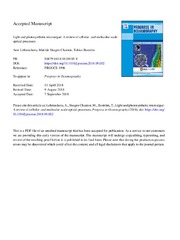Light and photosynthetic microalgae: A review of cellular- and molecular-scale optical processes
Permanent lenke
https://hdl.handle.net/10037/13853Dato
2018-09-08Type
Journal articleTidsskriftartikkel
Peer reviewed
Sammendrag
Light and its interaction with microalgae are essential concerns in the context of microalgae studies. The optical properties of microalgae have a great impact on the remote sensing ocean color, underwater light distribution and biomass accumulation, to mention some areas. A deep understanding of these processes requires knowledge on both the physical light interaction mechanisms with algae, and effects in cellular photophysiology and eventually primary production. Therefore, in this review we comprehensively explain the fundamental physical principles behind microalgae optical properties addressing the multidisciplinary microalgae community. We try to answer what happens with light in the microalgal cell on the cellular and molecular level, and explain the physical mechanisms of light absorption, scattering, fluorescence and diffraction. The current optical cell models that describe the absorbance and scattering properties of microalgae are compared and reviewed. The recent discoveries of the behavior of light in diatom frustules and coccolithophore coccoliths are represented, also showing the special role of these microalgae groups in terms of light interaction. Because microalgae and light are reciprocally interacting, we will briefly also view the photoacclimation and chromatic regulation associated with physical, metabolic and gene transcriptory changes. Finally, predictions and suggestions on the future research directions within oceanography, limnology, remote sensing and aqua culture are provided.
Beskrivelse
Accepted manuscript version. Published version available at https://doi.org/10.1016/j.pocean.2018.09.002. Accepted manuscript version, licensed CC BY-NC-ND 4.0.


 English
English norsk
norsk